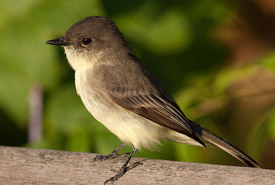Darwin, phoebe and International Biodiversity Day

Eastern phoebe (Photo by John Benson, Wikimedia Commons)
I saw an eastern phoebe yesterday.
Phoebes are small and drab birds, they don’t have a pretty song, they don't do anything particularly endearing, other than bob their tails when perched on branches. I know, I know...big deal.
Phoebes usually only attract attention from two groups of people: nerdy bird watchers with binoculars swinging from their necks, and rural homeowners who find piles of phoebe faeces under the rafters of their porches.
But before I saw the phoebe, I learned that May 22 is the International Day for Biological Diversity. The United Nations designated this annual day to enhance public awareness of the importance of biodiversity conservation. Despite the wrath that humans have unleashed on the planet, I can’t help but think that Charles Darwin himself would be pleased that we have set aside a day in honour of nature’s diversity.
Darwin was nothing if not a keen observer of the life he saw around him. Among other things, he studied beetles and barnacles and wrote a book about earth worms and vegetable moulds. Not exactly thrilling subject matter at first glance. That said, barnacles do have the longest penises of any animal in proportion to their body size.
Simply put, Darwin did not discriminate between sexy, toothy megafauna and eensy bugs. Yet his keen observations of small critters helped lead him to his revolutionary insights that fundamentally changed our ideas about one of the grandest of mysteries of all — the origins of the diversity of life on Earth.
Life on Earth! What could be a more compelling mystery in an entire Universe of (at least mostly) uninhabitable space? Sure, maybe there are, or were, microscopic organisms on Mars. But compared to the carnival of life on Earth, Mars is a wasteland.
Now, back to phoebe.
I found her when she flushed from her nesting site in the rafters above my car port.
There are a couple things to mention here, lest we overlook how flabbergasting they are. Firstly, this is most certainly the very same bird that nested in this exact location last year. Secondly, not long ago, this little bird was in Florida or Mexico and arrived in this precise place after flying hundreds of kilometres without any navigational gadgetry. No map. No compass. No satellite-guided GPS. By comparison, we often get lost while navigating our heavily signed highways and roads.
Yes, migratory birds are common and we all know they migrate huge distances, but I think we seldom consider how remarkable that truly is. For example, some bar-tailed godwits have been know to migrate 11,000 kilometres, non-stop, relying on large fat reserves (which make up 55 per cent of their pre-migration body weight) to see them through.
Our little phoebe travelled a fraction of that distance, but how many humans can say they travelled from Mexico to Quebec completely on their own steam? There are a few to be sure, but these are largely freakish exceptions. And it would have taken them a heck of a lot longer than took phoebe, likely weeks longer. By comparison, billions of birds migrate to northern Canada from southern climes, and back, every year.
So while this drab little phoebe works on rearing her brood of chicks, I will strive to watch the finer details of her existence through the eyes of Darwin, with an attentive sense of awe and wonder. What better way to honour the International Day for Biodiversity, on May 22 and beyond?
This article originally appeared in Tim Irvin's blog and is reposted with permission on Land Lines.


